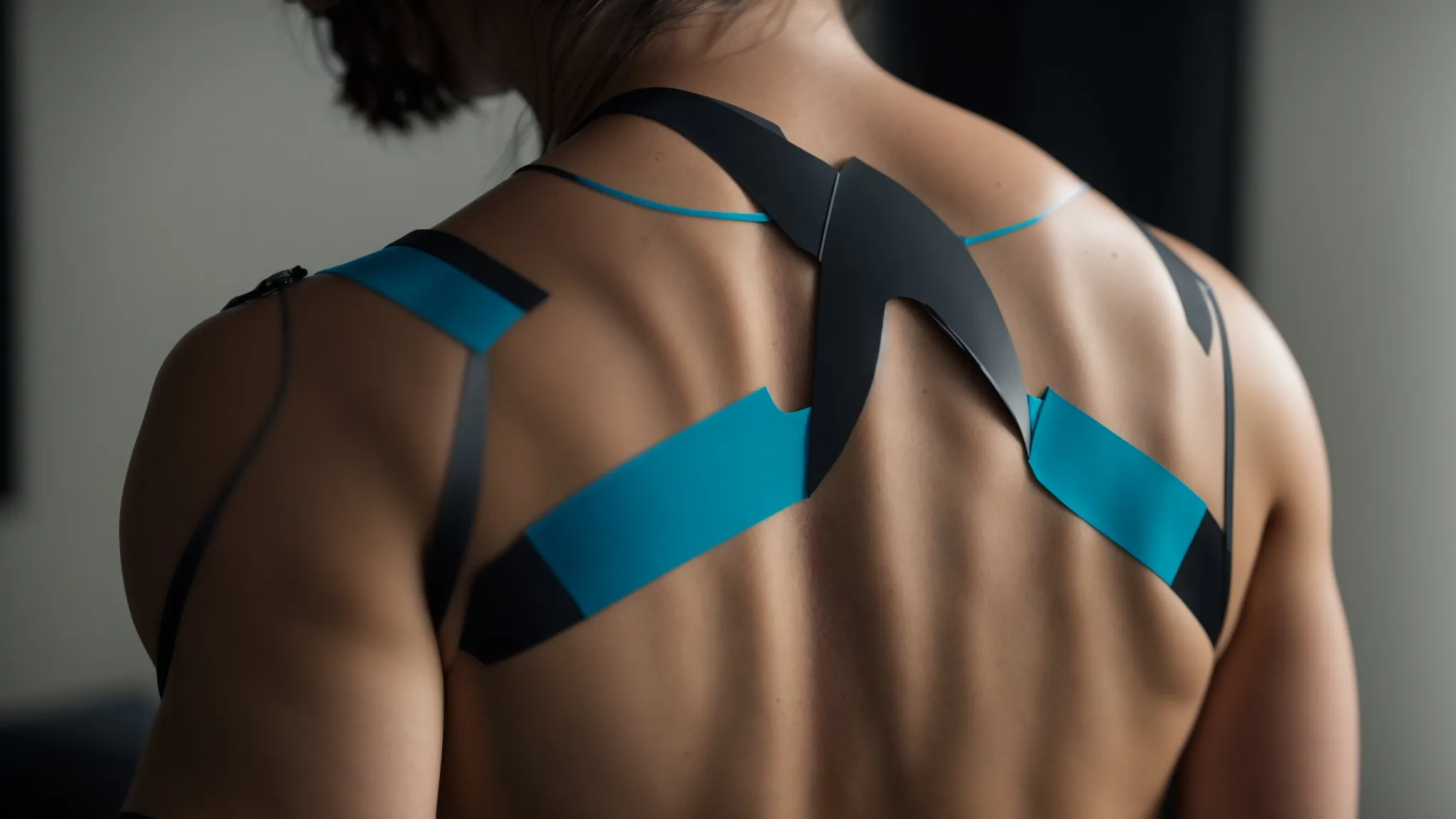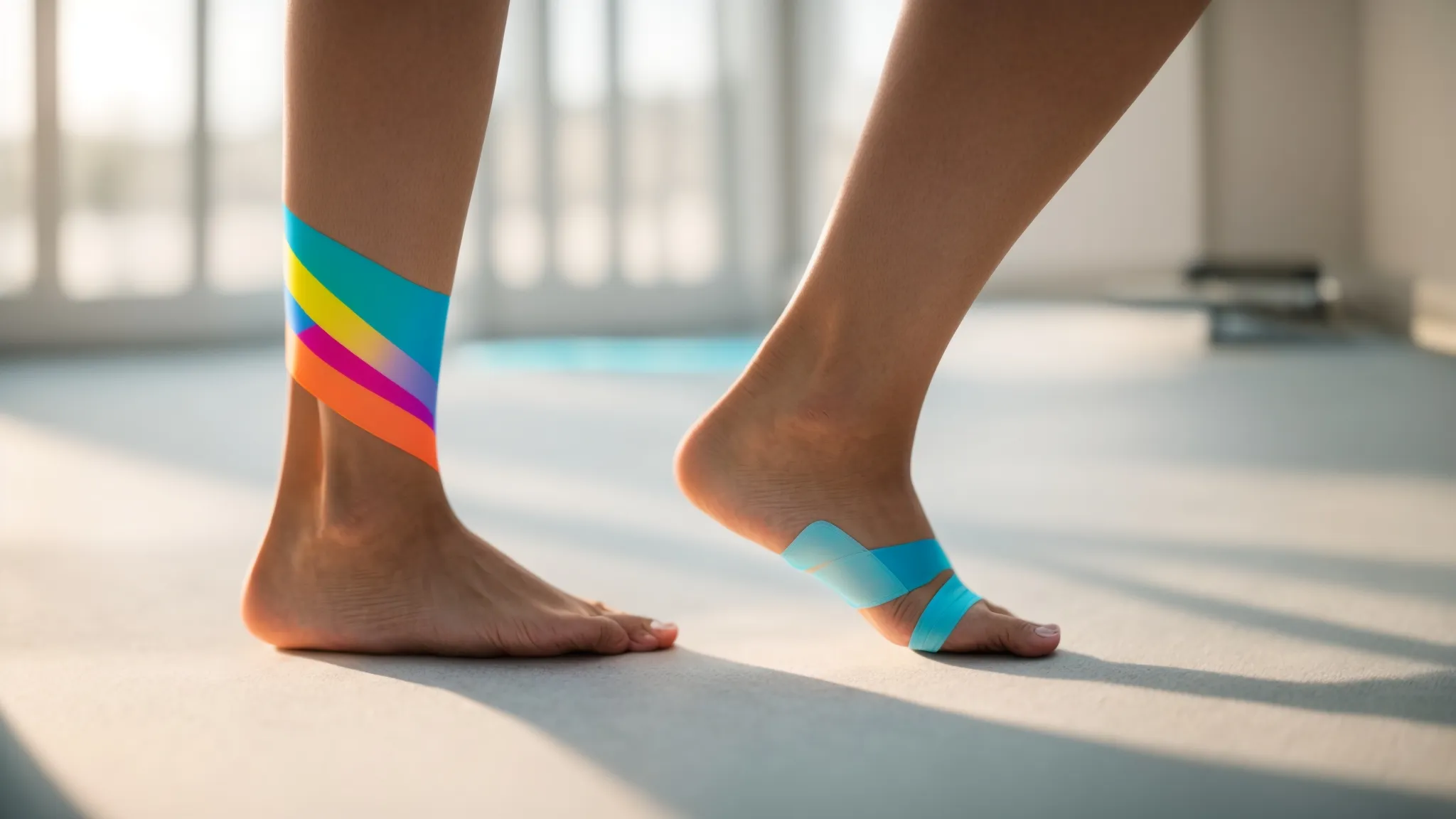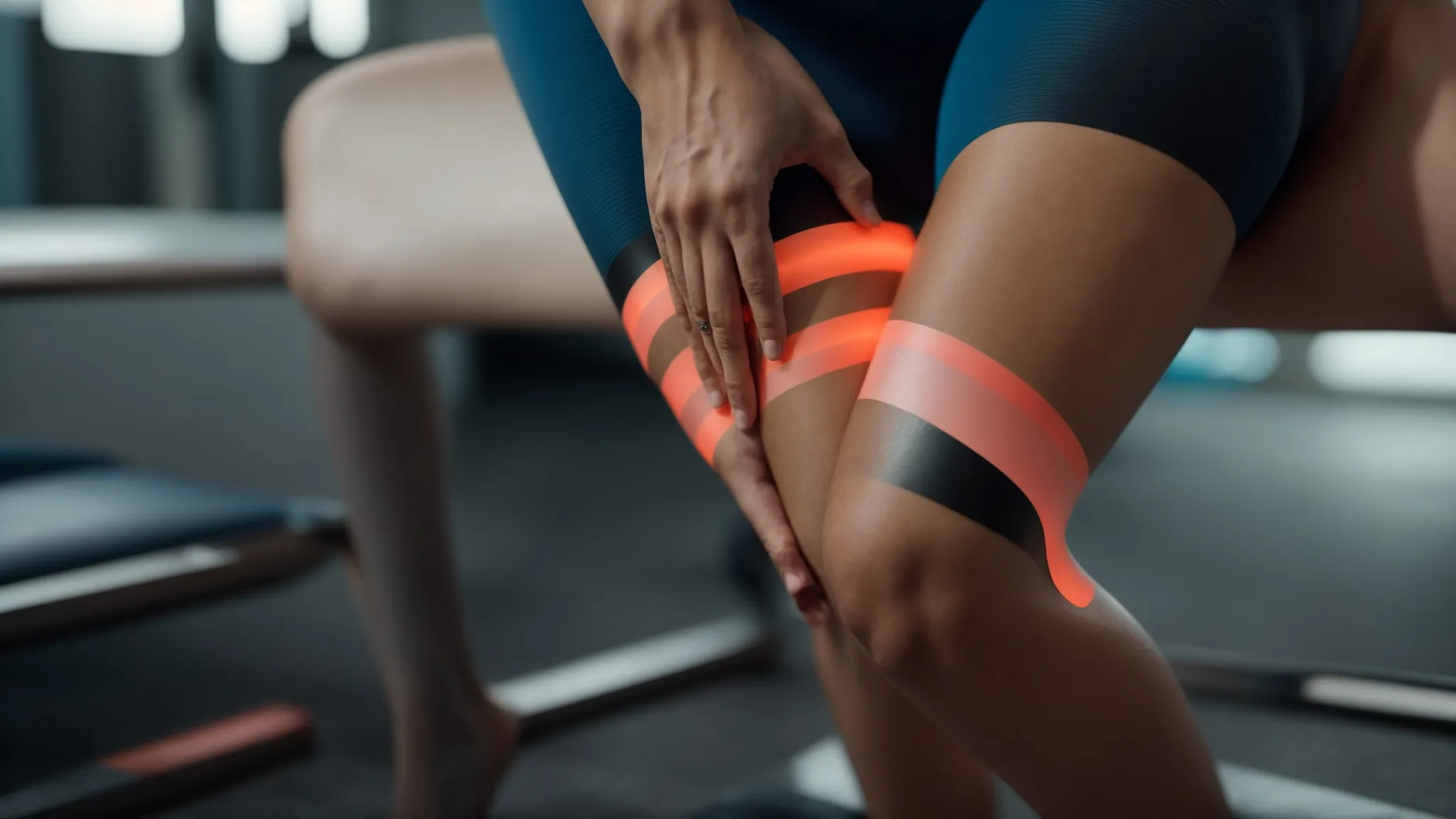Kinesio Taping: Transforming Strategies in Rehabilitation
Injuries can leave you feeling frustrated and unsure about the best path to recovery. Kinesio taping offers innovative strategies that can significantly enhance your rehabilitation process, particularly for issues related to the sensory nervous system or conditions like Achilles tendon injuries. In this post, I will discuss the impact of kinesio taping on rehabilitation strategies, explore various applications, and share evidence supporting its effectiveness. By understanding these techniques, you can take active steps toward improving your mobility and ensuring a smoother recovery, aligning with chiropractic principles and physiological needs.
Key Takeaways
- Kinesio taping enhances muscle strength and support while allowing for natural movement
- This technique aids recovery by improving lymphatic drainage and reducing discomfort
- Proper application of kinesio tape boosts joint alignment and mobility
- Combining kinesio taping with other therapies optimizes patient rehabilitation outcomes
- Research supports kinesio taping’s effectiveness in alleviating pain and enhancing recovery
Introduction to Kinesio Taping in Rehabilitation

Kinesio taping has its origins in Japan and has evolved into a widely recognized technique in Kinetic Chiropractic rehabilitation. I focus on the core principles behind this innovative physical rehab method, which emphasizes support and motion without restricting mobility. Through its application, especially for conditions like lymphedema, I can improve our patients' perception of discomfort and enhance their recovery journeys.
In this section, I will share insights into the origins and evolution of kinesio taping, as well as explain its foundational principles, which can significantly aid in physical rehab recovery and overall motion improvement. Electric Muscle Stimulation, Chiropractic Services
The Origins and Evolution of Kinesio Taping
Kinesio taping originated in Japan in the 1970s, developed by Dr. Kenzo Kase. He aimed to create a method that provided support and stability to muscles and joints without restricting their freedom of movement. This technique quickly gained traction and is now widely used in physical rehab, especially for patients recovering from joint replacement surgery and those dealing with conditions like patellofemoral pain syndrome and myofascial pain syndrome. Contact Us
Throughout the years, kinesio taping has evolved into a versatile tool in physical physical rehab therapy Kinetic Chiropractic. By addressing risks associated with unimpeded movement during recovery, it has become essential for many rehabilitation strategies. The application of tape enhances circulation and diminishes discomfort, significantly aiding recovery for many individuals facing surgical challenges or chronic conditions: Chiropractic Services
- Originated in Japan by Dr. Kenzo Kase in the 1970s
- Initially aimed at providing support without restricting movement
- Widely recognized for aiding recovery in joint replacement and pain syndromes
- Focused on reducing pain and enhancing mobility during rehab
Core Principles Behind the Technique
The core principles of kinesio taping revolve around enhancing muscle strength and support while allowing for natural movement. This technique is particularly beneficial for patients with osteoarthritis, as it promotes proper alignment and reduces joint pain by encouraging better circulatory flow through careful application of physical rehab. Through careful application of Kinetic Chiropractic, I have observed that patients experience notable improvements in mobility, allowing them to engage in essential stretching activities that can further aid their recovery.
Research and experiments have shown the statistical significance of kinesio taping in reducing pain and enhancing functional abilities in various conditions such as physical rehab. For instance, after implementing this technique in rehabilitation plans, many patients report increased comfort and confidence in their movements. This direct application not only supports recovery but also actively empowers individuals to take charge of their well-being and regain their strength:
- Enhances muscle strength without restricting motion
- Supports recovery for osteoarthritis patients through better alignment
- Encourages beneficial stretching movements
- Statistical significance proven by research on functional improvements
Kinesio taping offers a new path to healing, simple yet powerful in its approach. Let’s explore how it reshapes rehabilitation strategies and aids recovery.
Impact of Kinesio Taping on Rehabilitation Strategies

Kinesio taping plays a vital role in rehabilitation by enhancing muscle function and support. It facilitates lymphatic drainage and healing, which is crucial for recovery from physical rehab conditions like back pain, neck pain, and tennis elbow. Additionally, it improves joint alignment and mobility, making it a valuable tool in health care. Each of these aspects contributes to a comprehensive approach to recovery, empowering patients to regain strength and movement.
Enhancing Muscle Function and Support
As a clinician, I can attest to the transformative impact kinesio taping has on enhancing muscle function and support during physical rehab. When applied correctly by a physical therapist, the tape provides targeted pressure and support to the muscles, which can significantly improve neurology and motor function recovery. This is especially beneficial for patients dealing with muscle weakness or instability, as the support from the tape encourages proper form and range of motion, ultimately aiding in their recovery journey. Chiropractic Services
In my practice, I have observed that kinesio taping can effectively lengthen the muscles while still allowing for natural movement. This adaptability enhances overall functionality, enabling patients to engage in physical rehab exercises and daily activities more comfortably with Electric Muscle Stimulation. By alleviating discomfort and promoting stability, kinesio taping empowers patients to regain confidence in their physical abilities, paving the way for a more successful recovery process.
Facilitating Lymphatic Drainage and Healing
Facilitating lymphatic drainage is a pivotal aspect of my approach to physical rehab, especially when dealing with injuries such as a hamstring strain. Kinesio taping helps create space beneath the skin, which enhances fluid movement and reduces swelling in the affected areas. This technique not only optimizes recovery but also supports healing tissue, enabling patients to return to their activities more swiftly and with reduced discomfort. Contact Us Chiropractic Services
There is evidence that kinesio taping effectively contributes to healing by promoting better circulation. I have observed that when I incorporate this method in physical rehab plans, patients often experience a noticeable decrease in tenderness around tendons and muscles with Electric Muscle Stimulation. This improved lymphatic flow can be crucial in preventing future injuries and ensuring a more comprehensive recovery, allowing individuals to regain their mobility and confidence in their physical abilities.
Improving Joint Alignment and Mobility
In my experience, kinesio taping significantly improves joint alignment and mobility, especially in areas like the shoulder and neck. By strategically applying tape, I support the body's natural biomechanics using physical rehab, helping to ensure that these joints move correctly and efficiently. Patients often report a greater range of motion and less discomfort during exercises and daily activities, which directly contributes to their rehabilitation progress. Conditions Treated Contact Us
I've seen firsthand how Kinetic Chiropractic taping allows for the release of tension in the muscles surrounding these joints. For instance, when I integrate this approach in physical rehab therapy, patients feel immediate relief and enhanced stability, enabling them to perform movements that may have previously caused pain. This method not only helps to restore function but also promotes confidence, allowing individuals to engage in their recovery process with more enthusiasm and assurance.
Kinesio taping changes the way we think about healing. Its uses extend far beyond the clinic, opening doors to new possibilities in rehabilitation.
Diverse Applications of Kinesio Taping

Kinesio taping is a versatile tool in my physical rehab practice, offering benefits across various contexts. I often use elastic therapeutic tape to address sports-related injuries, manage chronic pain conditions, and support neurological rehabilitation efforts Electric Muscle Stimulation. Research supports its effectiveness, even in geriatrics, enhancing recovery and functioning alongside other physical therapy techniques. Each application highlights its potential to improve patients' lives.
Addressing Sports-Related Injuries
In my experience, kinesio taping has been invaluable in addressing sports-related injuries, particularly for areas like the elbow where players often face challenges such as tendinitis or ligament strains. By applying kinesio tape strategically, I facilitate lymphatic drainage through optimized fluid dynamics, which helps reduce swelling and enhances recovery physical rehab. This method not only alleviates discomfort but also supports the injured muscles by promoting better movement mechanics during their rehabilitation. For more information on Chiropractic Services, Conditions Treated, or Nutritional Therapy, feel free to Contact Us.
I also utilize Electric Muscle Stimulation combined with physical rehab and kinesio taping to enhance muscle activation in athletes recovering from injuries. By integrating techniques like electromyography, I can monitor muscle engagement, ensuring that my patients achieve proper movement patterns as they heal. Whether managing a tennis elbow or a strain from cutting movements in basketball, kinesio taping empowers athletes to reclaim their functionality and confidence, paving the way for a successful return to their sport:
- Kinesio taping supports injuries such as elbow tendinitis.
- Facilitates lymphatic drainage and reduces swelling effectively.
- Combines with functional electrical stimulation for better muscle activation.
- Utilizes electromyography to monitor patient progress and success.
Managing Chronic Pain Conditions
In my practice, I regularly observe the positive effects of Kinetic Chiropractic taping when managing chronic pain conditions, such as low back pain. By applying tape strategically around the lower back, I can support the muscles and improve stability, which is crucial for patients struggling with pain. This method not only eases discomfort but also encourages a more efficient gait, allowing individuals to carry out daily activities with greater ease and confidence. If you would like more information about our Chiropractic Services, Conditions Treated, or to Contact Us, please feel free to reach out.
Kinesio taping also plays a significant role in the rehabilitation of patients recovering from a stroke. By focusing on areas such as the forearm, I can assist with muscle activation and help enhance motor function. The support provided by the tape promotes better movement patterns, empowering those affected by stroke to regain strength and mobility physical rehab, essential steps towards their overall recovery journey. Kinetic Chiropractic
Supporting Neurological Rehabilitation Efforts
In my approach to neurological rehabilitation, I have found kinesio taping to be an effective method for supporting patients recovering from conditions such as stroke or traumatic brain injury. The adhesive properties of the tape provide support to the fascia and surrounding muscles, helping to reduce muscle fatigue and promote better movement patterns. In a randomized controlled trial, evidence suggested that patients experienced improved motor functions and enhanced stability when kinesio tape was applied correctly. I offer physical rehab services, including Electric Muscle Stimulation, Nutritional Therapy, and Ergonomic Advice, to help patients in their recovery.
By strategically applying kinesio tape around physical rehab and muscles, I can help create a supportive environment that encourages engagement and rehabilitation. This method not only aids in reducing discomfort but also boosts patients’ confidence in their physical abilities. Each application of Kinetic Chiropractic encourages active participation in their recovery process, empowering them to work towards regaining their strength and mobility:
- Kinesio taping supports recovery from stroke and brain injuries.
- The adhesive properties help reduce muscle fatigue.
- Improves motor function and stability through effective application.
- Engages patients in their rehabilitation journey with increased confidence.
Kinesio taping can be a powerful tool in your recovery toolbox. Now, let’s delve into the techniques that will elevate your skills and enhance your practice.
Mastering Kinesio Taping Techniques

To master kinesio taping effectively, I focus on key areas such as selecting appropriate tape and materials, understanding step-by-step application methods, and recognizing common mistakes to avoid physical rehab. The right tape with optimal elasticity can enhance efficacy in treating Conditions Treated knee pain. By applying these techniques correctly, we can harness the necessary force for improved recovery outcomes and empower our patients on their healing journeys.
Selecting Appropriate Tape and Materials
Selecting the right Kinetic Chiropractic tape is crucial for effective physical rehab, especially when addressing conditions related to hip injuries or inflammation. I prefer using high-quality, elastic therapeutic tape designed for the specific needs of Kinetic Chiropractic Services physical therapy. The appropriate tape not only adheres well to the skin but also provides the right amount of support while allowing for natural movement, making it easier to engage the connective tissue without causing discomfort.
In my experience, the difference between a successful outcome and a placebo effect often lies in the selection of materials. Tapes with varying elasticity can target specific areas effectively, such as the hip, promoting better circulation and reducing inflammation. By choosing physical rehab the right tape, I help my patients maximize their recovery, ensuring they feel supported and empowered throughout their rehabilitation journey.
Step-by-Step Application Methods
To effectively apply kinesio tape, I start by preparing the skin. It's essential to ensure that the area is clean and free from oils or lotions. When I work with patients recovering from a knee replacement or dealing with tendinopathy, I explain that I will cut strips of tape tailored to the specific tissue I need to support physical rehab. The application method varies depending on the intended outcome, but I generally begin by applying the base of the tape without stretch and then gradually pull on the tape while applying it to the target area. This technique promotes support for their activities of daily living while allowing for the necessary movement.
After I’ve laid down the tape, I make sure to rub it gently to activate the adhesive properties, which ensures better adherence and functionality. Applying kinesio tape requires consideration of the direction of muscle fibers and joint movements. For example, when supporting knee recovery, I focus on applying the tape to enhance stability and reduce discomfort during rehabilitation exercises. Following these step-by-step physical rehab application methods not only aids in recovery but also empowers my patients, providing them with the confidence to engage in their therapeutic activities effectively.
Common Mistakes to Avoid
When applying kinesio tape, one common mistake is not preparing the skin properly. It's crucial to cleanse the area of any oils or lotions to prevent irritation and ensure the tape adheres effectively. I’ve seen cases where lack of preparation leads to tape lifting during movement, causing fatigue and reducing the benefits of the technique. If the tape doesn't stay put, it won't support the muscles or joints as intended, potentially worsening symptoms like fatigue or discomfort in conditions such as tendonitis or other syndromes. Kinetic Chiropractic for more information on Conditions Treated.
Another mistake I often observe is applying physical rehab the tape in the wrong direction concerning muscle fibers and joint movement. Incorrect application can hinder fluid movement and restrict the benefits of kinesio taping. For example, when I notice a client struggling with knee pain, ensuring the tape follows the right muscle orientation becomes essential for enhancing mobility and reducing pain. Taking the time to guide each application correctly is a vital step toward a more effective Kinetic Chiropractic rehabilitation experience:
- Prepare the skin thoroughly to prevent irritation.
- Apply tape in the direction of muscle fibers.
- Ensure proper tension for optimal support and fluid movement.
- Consider using kinesio taping alongside other techniques for best results.
Now that we understand the art of kinesio taping, let’s look at what the research says. The evidence supports its promise, revealing how it can actually help in recovery.
Evidence Supporting Kinesio Taping Effectiveness

Evidence Supporting Kinesio Taping Effectiveness
I have encountered numerous clinical research findings that affirm the effectiveness of kinesio taping in physical rehab. Studies show that it plays a significant role in pain management, especially for conditions such as anterior cruciate ligament injury Kinetic Chiropractic, carpal tunnel syndrome, and enhancing lymphatic system function. Through case studies, I've witnessed success stories where patients experience improved mobility and reduced discomfort, particularly around the malleolus during recovery. If you have any questions regarding these Conditions Treated or are interested in Chiropractic Services, please Contact Us for more information.
These insights not only highlight the practical applications of kinesio taping but also emphasize its impact on patients' overall well-being. In the upcoming sections, I will delve deeper into both the research findings and real-world examples, showcasing how kinesio taping, Electric Muscle Stimulation transforms rehabilitation strategies for a range of physical rehab conditions.
Clinical Research Findings
In my practice, I’ve seen compelling evidence from clinical research illustrating how kinesio taping can enhance muscle function and improve overall rehabilitation outcomes. Studies have shown that this technique not only supports the muscles during recovery but also plays a significant role in blood circulation, leading to quicker healing times. For instance, I recently worked with an athlete recovering from a knee injury, and the integration of kinesio taping resulted in noticeable improvements in his mobility and comfort, demonstrating its effectiveness in physical rehab and sports medicine.
Additionally, research indicates that kinesio taping can benefit individuals with varying body mass index (BMI) levels, making it adaptable to a wide range of patients. One study I reference often found that patients suffering from chronic pain diseases experienced reduced discomfort and improved functional ability when utilizing kinesio tape as part of their physical rehab plan. Such outcomes underscore the potential of kinesio taping as a valuable tool in my efforts to support patients in their recovery journeys, regardless of their specific circumstances.
Case Studies Highlighting Success Stories
In my practice, I have witnessed remarkable success stories through case studies that highlight the effectiveness of kinesio taping. For example, one patient struggling with knee pain reported significant improvements in mobility and comfort after my intervention using physical rehab techniques. This particular case underscored how the proper application can enhance the anatomy and function of the knee joint, enabling patients to resume walking more confidently.
Another compelling case involved a patient with upper limb dysfunction. After implementing kinesio taping as part of their physical rehab plan, this individual experienced a notable increase in their range of motion and strength with Kinetic Chiropractic. A systematic review of the findings further confirmed that such treatments not only relieved discomfort but also fostered overall recovery by supporting tissue and muscle integrity. These examples demonstrate how kinesio taping can be a transformative tool in rehabilitation, addressing specific needs and improving quality of life:
- Patient with knee pain experienced improved mobility.
- Kinesio taping enhanced knee joint function.
- Upper limb patient gained range of motion and strength.
- Systematic review supported the effectiveness of treatments.
We’ve seen how kinesio taping proves its value in recovery and support. As we look ahead, new possibilities arise that could shape its role in rehabilitation.
Future Directions in Kinesio Taping

In exploring the future directions of physical rehab, specifically Kinetic Chiropractic, I’ll focus on two key areas: technological advancements in tape design and the integration of taping into comprehensive rehabilitation plans. These developments promise to enhance recovery outcomes for patients dealing with conditions like delayed onset muscle soreness, anterior cruciate ligament injuries, and muscle contraction issues. I’ll also discuss how innovative approaches, such as myofascial release techniques paired with kinesio taping, can optimize the effectiveness of treatments for skeletal muscle health.
Technological Advancements in Tape Design
Technological advancements in kinesio tape design have significantly enhanced our ability to promote motor control and support soft tissue recovery. These innovations include tapes with improved elasticity and breathability that maintain optimal adherence while allowing for greater range of motion. By utilizing these advanced materials, I can better address patients' specific needs, ensuring that the tape not only supports their injuries Chiropractic Services but also actively contributes to their physical rehab journey. Contact Us
Moreover, integrating techniques like the active release technique with modern tape designs Kinetic Chiropractic offers a more comprehensive approach to healing. For instance, I often apply Kinetic Chiropractic tape to areas near a wound or injury while employing physical rehab movements to facilitate healing while maintaining muscular function. This synergy not only alleviates discomfort but also helps my patients optimize their recovery as they regain strength and movement confidently.
Integrating Taping Into Comprehensive Rehabilitation Plans
Integrating kinesio taping into comprehensive physical rehab plans has proven to enhance recovery outcomes significantly. By combining this technique with manual therapy, I can create a balanced approach that targets not only the symptoms but also the underlying issues. For instance, when I work with patients recovering from surgery, I find that incorporating taping alongside Electric Muscle Stimulation treatments improves lymphatic drainage, which is crucial for reducing swelling and promoting healing. This integration allows me to support my patients in achieving the highest level of mobility and function in their daily lives. Additionally, I utilize physical rehab sampling techniques in my assessments to tailor kinesio taping to each patient's unique needs and conditions. When I have patients struggling with chronic pain or mobility issues, I guide them through exercises that complement the tape's support, ensuring that they regain balance in their movements. This collaborative approach not only empowers my patients but also provides them with the confidence to engage fully in their rehabilitation journey, fostering a sense of ownership over their recovery process.
Conclusion
Kinesio taping significantly transforms rehabilitation strategies by enhancing muscle function, promoting better alignment, and facilitating healing for various conditions. This innovative technique empowers patients, allowing them to engage actively in their recovery journey while reducing pain and improving mobility. By incorporating kinesio taping into comprehensive rehabilitation plans, clinicians can address both symptoms and underlying issues more effectively. Ultimately, kinesio taping is an invaluable tool that supports patients in regaining their strength and confidence, making it essential in modern rehabilitation practices.
